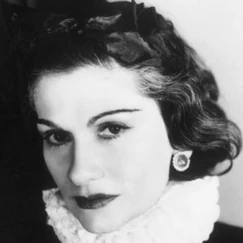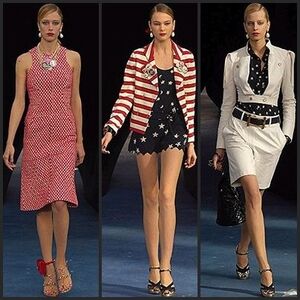
Gabrielle Bonheur "Coco" Chanel (19 August 1883 – 10 January 1971) was a pioneering
French fashion designer whose modernist philosophy, menswear-inspired fashions, and pursuit of expensive simplicity made her an important figure in 20th-century fashion. She was the founder of the famous fashion brand Chanel. Her extraordinary influence on fashion was such that she was the only person in the couturier field to be named on Time 100: The Most Important People of the Century.
Simple is better[]
For Miss Chanel, simple was better and her quote for that is: "Before you go out, always take something off".
Examples of Work[]
History[]
From her first shop, opened in 1912, to the 1920s, Gabrielle 'Coco' Chanel rose to become one of the premier fashion designers in Paris, France. Replacing the corset with comfort and casual elegance, her fashion themes included simple suits and dresses, women's trousers, costume jewelry, perfume and textiles.
Coco Chanel claimed a birthdate of 1893 and a birthplace of Auvergne; she was actually born in 1883 in Saumur. According to her version of her life story, her mother worked in the poorhouse where Gabrielle was born, and died when Gabrielle was only six, leaving her father with five children whom he promptly abandoned to the care of relatives.
Coco Chanel drew on the resources of these patrons in setting up a millinery shop in Paris in 1910, expanding to Deauville and Biarritz. The two men also helped her find customers among women of society, and her simple hats became popular.
Soon "Coco" was expanding to couture, working in jersey, a first in the French fashion world. By the 1920s, her fashion house had expanded considerably, and her chemise set a fashion trend with its "little boy" look. Her relaxed fashions, short skirts, and casual look were in sharp contrast to the corset fashions popular in the previous decades. Chanel herself dressed in mannish clothes, and adapted these more comfortable fashions which other women also found liberating.
In 1922 Coco Chanel introduced a perfume, Chanel No. 5, which became and remained popular, and remains a profitable product of Chanel's company. Pierre Wertheimer became her partner in the perfume business in 1924, and perhaps also her lover. Wertheimer owned 70% of the company; Chanel received 10% and her friend Bader 20%. The Wertheimers continue to control the perfume company today.
Coco Chanel introduced her signature cardigan jacket in 1925 and signature "little black dress" in 1926. Most of her fashions had a staying power, and didn't change much from year to year -- or even generation to generation.
She briefly served as a nurse in World War II. Nazi occupation meant the fashion business in Paris was cut off for some years; Chanel's affair during World War II with a Nazi officer also resulted in some years of diminished popularity and an exile of sorts to Switzerland. In 1954 her comeback restored her to the first ranks of haute couture. Her natural, casual clothing including the Chanel suit once again caught the eye -- and purses -- of women. She introduced pea jackets and bell bottom pants for women. She was still working in 1971 when she died. Karl Lagerfeld has been chief designer of Chanel's fashion house since 1983.
In addition to her work with high fashion, Chanel also designed stage costumes for such plays as Cocteau's Antigone (1923) and Oedipus Rex (1937) and film costumes for several movies, including Renoir's La Regle de Jeu. Katharine Hepburn starred in the 1969 Broadway musical Coco based on the life of Coco Chanel.

